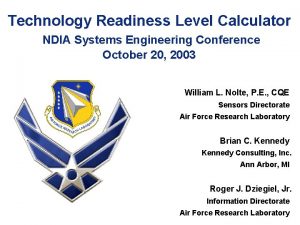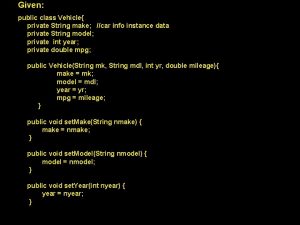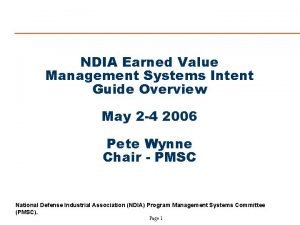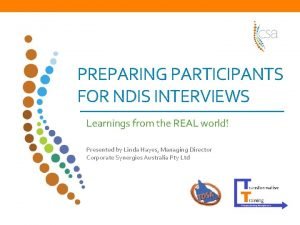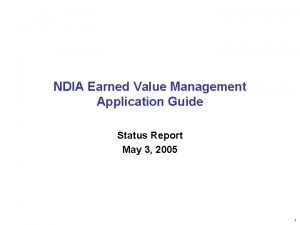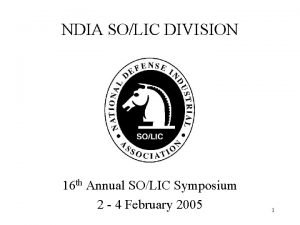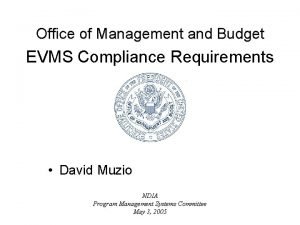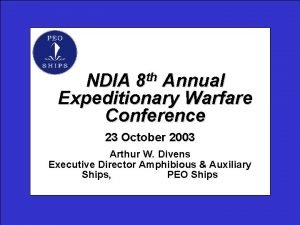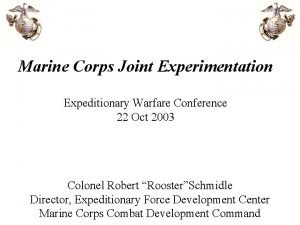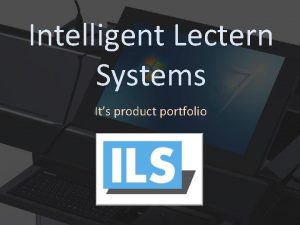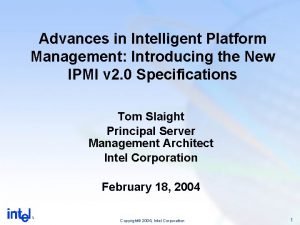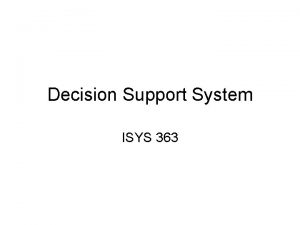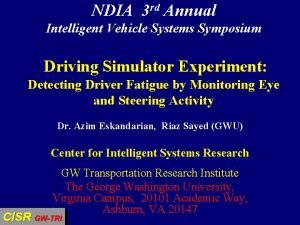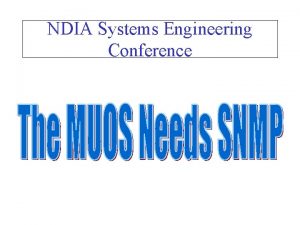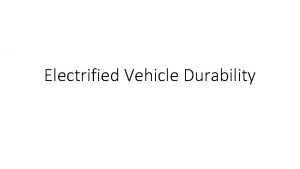NDIA 3 rd Annual Intelligent Vehicle Systems Symposium
















- Slides: 16

NDIA 3 rd Annual Intelligent Vehicle Systems Symposium & Exhibition Small Business Innovation Research (SBIR) Workshop “Process & Project” A Contractor’s Perspective American Systems Technology Incorporated 888 W. Big Beaver Road Troy, MI 48084 Mr. Brian L. Crankshaw, Gov. Systems Bus. Operations Copyright. V. P. American Technology Inc. Technology 2003 Mr. Michael Losh, V. P. Core

Presentation Agenda • ASTI Overview • ASTI SBIR Contract Awards • SBIR Proposal Process Keys • SBIR Program Benefits • SBIR Phase I-II-III Key Distinctions • SBIR Considerations & Recommendations • Current ASTI Phase II Contract Overview • Questions Copyright American Systems Technology Inc. 2003

Corporate History & Highlights • Founded 1992 • Received 8(a) certification December 15, 1999. • Business Areas: • Engineering Services - (Automotive & Defense) • Business Operating Systems (BOS) - (Commercial, Nonprofit, Education, & Defense) • International Business - (Asian Pacific Import/Export) • Various partnership programs • Approximately 30 employees Copyright American Systems Technology Inc. 2003

SBIR Contract Awards • Micromachine Robot for Automotive Diagnostics, Visualization & Sensing (U. S. Army) • Phase I awarded March 2002 • Phase I option awarded August 2002 • Phase II awarded February 2003 • 42 -Volt System Conversion (U. S. Army) • Phase I awarded 12 Dec. 2002 • Phase II submitted May 2003. Award pending. Copyright American Systems Technology Inc. 2003

SBIR Proposal Process Keys • Early identification of potential topics • Utilize discussion period … multiple times if necessary • Make technical contacts aware of your interest (let them know you are serious about the topic and technology) • Identify the Principal Researcher & other key personnel • Form partnerships with potential subcontractors or consultants • Develop a proposal outline early • Don’t over/under-commit • Have non-technical people review the final Draft proposal • FOLLOW THE SUBMISSION GUIDELINES ! Different Agency …… Different Guidelines (especially for Phase II) Copyright American Systems Technology Inc. 2003

Different Agency … Different Guidelines “ Phase II Example” • NAVY: 40 pages including $150 k option proposal but excluding transition plan, commercialization report, supporting material. • DARPA: “recommended” max of 40 pages plus attachments, not to exceed total of 80 pages • AIR FORCE: max of 75 pages, plus attachments • MDA: no page limit • Do. ED: 25 double-sided pages plus appendices • NSF: 15 page limit on guts, 15 pages on commercialization plan, no overall limit • DOC, DOT, EPA, DOE: no limit, but……. • NASA: max of 50 pages • USDA: 50 pages plus attachments • DHHS/NIH: Items 1 -4 of research plan, 25 pages or less; Commercialization Plan 15 pages or less; otherwise, no overall proposal page limit. Copyright American Systems Technology Inc. 2003

SBIR Benefits • Innovative idea or technology development tool (great ideas can become great products) • Fosters R&D collaboration (subcontract and potential $ source – most small businesses cannot do everything) • Business plan & marketing partnership (look for a Phase III customer EARLY…Phase II funding allows for this) • Patent and IP protection (SBIR contractor retains IP) • Development of new in-house facilities and capabilities (leverage and expand existing capabilities with SBIR support) • Can build credibility in market • Can provide access to Copyright other American potential Systemsprojects Technology Inc. 2003

SBIR Phase I-II-III Key Distinctions Phase I • Any qualified small business can submit proposal(s). • Limited funding ($70 k) – Limited time (6 months) – Limited scope (Proof of Concept/Feasibility Study) Phase II • By invitation only (Army) • Expanded funding ($750 k) – Expanded time (up to 24 months) – Expanded Scope (Prototype development and testing) Phase III • Sole source by any Agency (products, production, services, R/R&D, or any combination thereof) • No SBIR funding (there must be a customer) • No limit on dollar value, duration or quantity of Phase III awards • New laws address Phase III (24 Sept 2002, SBA SBIR Program Policy Directive Copyright American Systems Technology Inc. 2003

SBIR Considerations & Recommendations • Verify or assess programmatic relevance of topic (FCS – Homeland Defense, etc. ) • Link Phase I and II work plans (show in timeline) • Highlight commercial impact & strategy (dual-use commercialization) • Develop a focused business plan (all phases considered) • Expect to “invest” your own time and resources beyond SBIR funding • Stay focused on developing the core technology while pursuing multidisciplinary applications Copyright American Systems Technology Inc. 2003

SBIR Considerations & Recommendations • Engage research projects that address critical national needs AND advance the core technology development • Establish collaborative relationships with others • Become involved with technology peer groups and gatherings • Stay in close contact with the Contracting Officer’s Rep. (COR). Face-to-face is best • Understand the Contract Administration and reporting obligations (DCAA, DCMA-ACO, COR, CO, DTIC, etc) • LET OTHERS KNOW WHAT YOU ARE DOING! (government, industry, media, State organizations, etc. ) Copyright American Systems Technology Inc. 2003

Phase II Embedded Diagnostics & Prognostics Project Overview Program Vision • TARDEC expressed interest in a “MEMS chip” that can be targeted to multiple diagnostic and prognostic applications on the vehicle and produced in high volumes • MEMS = Micro Electro-Mechanical Systems • ASTI added wireless digital communications as a critical element of an embedded diagnostics architecture Copyright American Systems Technology Inc. 2003

Phase II Embedded Diagnostics & Prognostics Project Overview Motivations Re adi nes ty i l i b ina s Embedded Diagnostic s and Prognostic s Safety e c n a m r fr o Pe ta s u S FCS BCT Legacy Commercial Longevity Co mm Tre erc nd ial s Copyright American Systems Technology Inc. 2003

Phase II Embedded Diagnostics & Prognostics Project Overview An Embedded Diagnostics and Prognostics Architecture Why an “architecture”? • Everything essential has its place • Elements are arranged to work well together • Design can be altered to fit client/customer’s needs • Provisions for future additions Copyright American Systems Technology Inc. 2003

Phase II Embedded Diagnostics & Prognostics Project Overview Integration with Vehicle & World Telematics & diagnostics display, user input RF or wired link Detached sensors with wireless or wired link ))) Detached sensors connected through vehicle data bus ))) Portable hand-held diagnostic scanner and data collection tool with RF transceiver CLOE*, other Data networks Vehicle data bus J 1939, J 1708, etc. Embedded Diagnostics Platform with attached Sensor(s) Data forwarded to commanders, maintenance depots, logistics, PMs, etc. Plug-in diagnostic equipment (e. g. SPORT) * CLOE = Common Logistics Operating Environment Copyright American Systems Technology Inc. 2003

Phase II Embedded Diagnostics & Prognostics Project Overview SBIR Program Phases • Phase I: Conceptual design & feasibility study • Phase II: Detailed design, simulation, prototype fabrication, laboratory evaluation • Phase II-Plus: Demonstrate additional diagnostic and prognostic applications, prepare for pilot production • “Phase III”: Initial production and commercialization Copyright American Systems Technology Inc. 2003

? ? ? Questions ? ? ? “You miss 100% of the shots you never take” Wayne Gretzky Mr. Brian L. Crankshaw, V. P. Gov. Bus. Operations 248 -362 -4100 x 26 Copyright American Systems bcrankshaw@amsystech. com Technology Inc. 2003
 Trl calculator excel
Trl calculator excel Decision support systems and intelligent systems
Decision support systems and intelligent systems Cosmic superclass in java
Cosmic superclass in java Ndia evms
Ndia evms Ndia evms application guide
Ndia evms application guide Introduction
Introduction Ndia interview
Ndia interview Ndia evms application guide
Ndia evms application guide Ndia solic
Ndia solic Ndis subcontracting
Ndis subcontracting Ndia evms
Ndia evms Ndia expeditionary warfare conference
Ndia expeditionary warfare conference Ndia expeditionary warfare conference
Ndia expeditionary warfare conference Ndia electronics division
Ndia electronics division Coreils
Coreils Intelligent platform management interface industry
Intelligent platform management interface industry Isys intelligent systems
Isys intelligent systems
